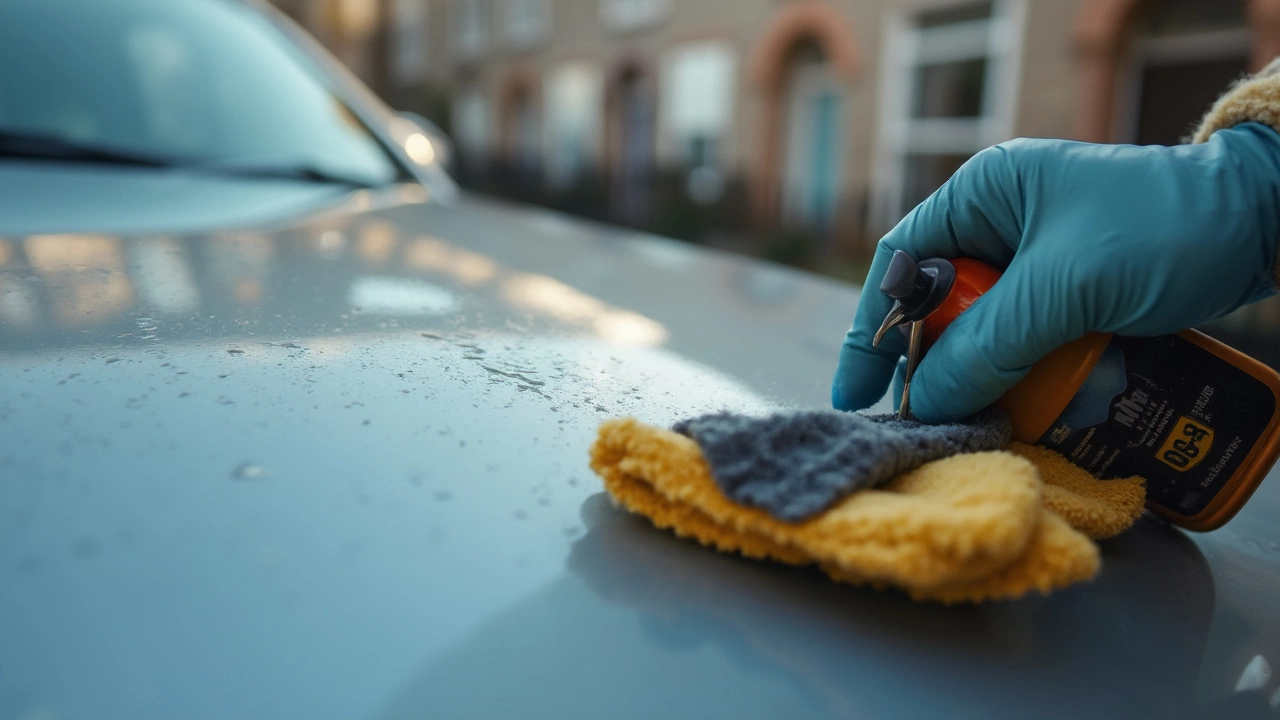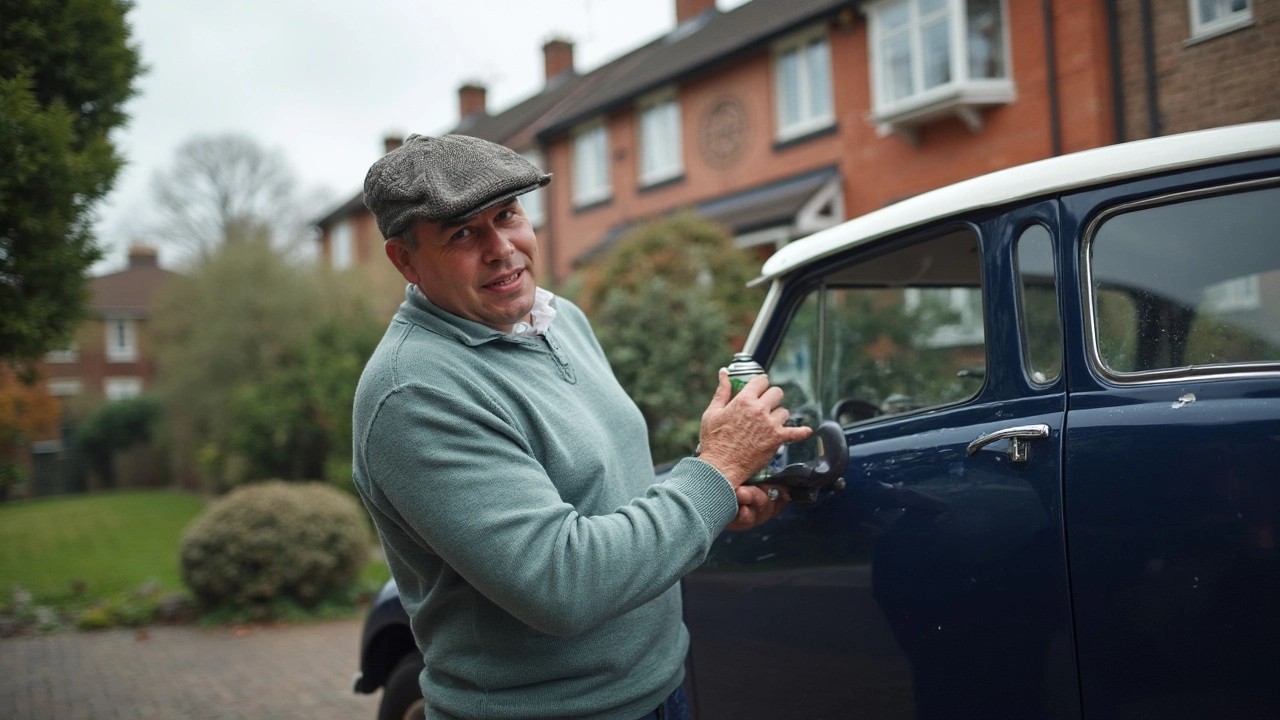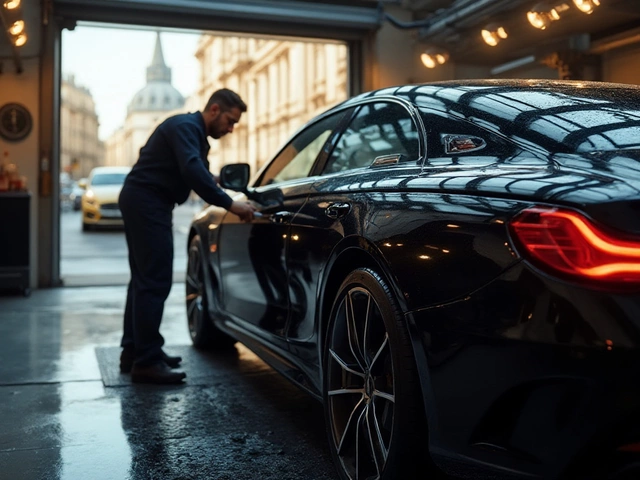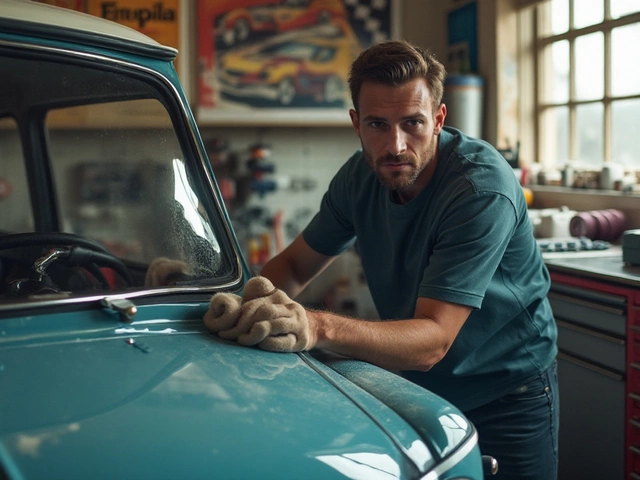Seeing a scratch on your car hurts, doesn’t it? There’s a million tips online, but one hack keeps popping up: WD-40 for scratch removal. Maybe you’ve already got a can in the garage for squeaky doors or rusty bolts—but what about your car’s paint?
Let’s get one thing straight: WD-40 isn’t actually made for cars. It was invented in the ‘50s as a rust-prevention spray for rockets. That said, over the years, people started spraying it onto everything, including their car’s paintwork, hoping it would do magic on fine scratches.
If you’re thinking of grabbing that blue-and-yellow can, slow down a second. WD-40 can make small scratches look less noticeable, but it doesn’t actually remove them. Instead, it hides light marks for a while, mostly by filling them in with oil and making the area shiny. For deep scratches, it’s about as effective as water, but with more smell. Want to know the full story and whether it’s worth using for your ride? Stick around.
- What’s the Deal With WD-40 on Car Scratches?
- How Does WD-40 Actually Work?
- Types of Scratches You’re Dealing With
- Will WD-40 Remove or Just Hide Your Scratch?
- Safe Ways to Use WD-40 on Your Car
- Smarter Alternatives to WD-40
What’s the Deal With WD-40 on Car Scratches?
So, why do people grab WD-40 when they see a scratch on their car? Truth is, WD-40 wasn’t made for cars at all. It’s short for "Water Displacement, 40th formula" and was first cooked up in 1953 to protect missile parts from rust and corrosion. It’s basically a mix of oils and solvents that’s good at breaking up gunk, displacing water, and getting things moving again—hence why it lives in garages everywhere.
Somewhere along the line, car owners started using it for more than rusty bolts. The story goes that since WD-40 is slippery and leaves a glossy film, it can hide little paint scuffs. That blue-and-yellow can gets grabbed for everything from bike chains to surface cleaning, so "fixing" car scratches was a natural next experiment.
According to WD-40’s own site, it’s safe on car paint, but that doesn’t mean it actually removes scratches. Instead, it just covers them up—kind of like buffing plastic with a little olive oil to make it shiny. The scratch doesn’t disappear; it just stands out less, especially under certain lighting. It’s more of a temporary band-aid than a real fix.
Check out this quick fact table to put things in perspective:
| Fact | Detail |
|---|---|
| First made | 1953, for the aerospace industry |
| Designed for | Rust removal, water displacement |
| Official stance on car paint | "Safe on paint," not a scratch remover |
| Effect on car scratches | Makes small marks look less noticeable for a short time |
Folks on car forums swap stories about WD-40 making scratches vanish, but it’s all temporary. Rain, washing, or a little time, and the scratch pops right back. For folks who want to keep their car looking sharp between wax jobs or before selling, it might help for a day or two—but nobody’s writing home about permanent results.
How Does WD-40 Actually Work?
WD-40 is basically a mix of oils, solvents, and some additives designed to keep metal from rusting and to loosen up stuff that’s stuck. The magic here is in its ability to spread out quickly and stick to surfaces, which makes it useful for a million small jobs around the house—just not for every car scratch.
When you spray WD-40 on your car, you’re not fixing the scratch itself. What it does is fill in the grooves of a fine scratch with oil, making the surface look smooth and reflective under light. It also cleans off grime and helps make old wax or polish shine again. That shiny look can trick your eyes into thinking the scratch is gone, even though it’s still there.
Here’s what happens step by step:
- The solvents help break down grease, dirt, or light adhesives sitting in the scratch.
- The oil creeps into shallow scratches, which makes the area reflect light differently. It’s kind of like putting lotion on dry skin.
- WD-40 leaves a thin, oily layer that repels water and makes the spot look freshly waxed—for a while.
But—and this is key—it doesn’t actually remove or repair the damage. The effect fades as the oil wears off or as you wash your car. If you want to actually fix the paint, you’ll need a proper car detailing kit made for scratch removal, not just a can of WD-40.
Types of Scratches You’re Dealing With
Before you reach for that can of WD-40, it helps to know what kind of scratch you’re up against. Not all scratches are the same, and the depth makes a huge difference for how easily you can fix them at home.
Your car’s paint has three layers: clear coat (the shiny, protective top), base coat (the color), and primer (the stuff that sits right on the metal). Scratches hit at different levels, which decide how tough they are to hide or fix.
- Clear Coat Scratches: These only scratch the surface. You usually spot them when you catch the light just right, like after someone brushes against your car with a shopping cart. They make up most scratches you see, and they’re the kind WD-40 might help hide—for a while.
- Base Coat Scratches: These go deeper. You’ll see a clear change in color, maybe even a darker line. At this level, a quick spray isn’t going to cut it. You’ll need more than WD-40 to fix the damage.
- Primer or Metal Scratches: Now we’re talking real trouble. If you see gray or even metal, your car’s not just scratched—it’s at risk of rust. DIY spray tricks won’t do much except maybe buy you a little time before things get worse.
Check out this quick breakdown of scratch types and what you’re likely up against:
| Scratch Type | Depth | WD-40 Effectiveness | Fix at Home? |
|---|---|---|---|
| Clear Coat | Surface only | Makes it less visible temporarily | Usually yes |
| Base Coat | Through color layer | Doesn’t fix, barely hides | Sometimes, with touch-up paint |
| Primer/Metal | Exposed primer or metal | No effect | No, needs pro repair |
Statistically, about 60–70% of car scratches are just in the clear coat according to auto detailing shops in the US. That’s good news if you’re looking for a quick fix, at least for appearances. For anything deeper, spraying WD-40 is like putting a bandage on a broken leg—it just won’t cut it.

Will WD-40 Remove or Just Hide Your Scratch?
If you’re hoping WD-40 will permanently erase scratches from your car, you might want to manage those expectations. The truth is, WD-40 doesn’t actually get rid of most scratches—it mostly just makes them less obvious. How? The spray contains oils and solvents that fill in those tiny grooves, so light reflects off them more evenly. Basically, it “masks” the scratch, especially on darker paints or when the scratches are very shallow.
Let’s break it down. Here’s what really happens when you spray WD-40 on a scratch:
- The oil fills the scratch, making it harder to see from some angles.
- It makes your paint glossier, which can distract from small swirl marks or scuffs.
- After a wash or heavy rain, the effect usually fades or disappears completely.
On anything deeper—think scratches that you can catch with your fingernail—WD-40 doesn’t stand a chance. The paint is actually damaged there, and no spray is going to fix that for good. If you want results that last, you’ll need something like polishing compound or professional touch-up paint.
Check out how WD-40 stacks up for scratch hiding power versus other quick fixes:
| Product | Works on light scratches? | Works on deep scratches? | How long it lasts | Average cost (USD) |
|---|---|---|---|---|
| WD-40 | Yes* | No | Until next wash (few days) | 6-8 |
| Scratch Remover Polish | Yes | Sometimes | Weeks to months | 10-25 |
| Touch-Up Paint | Yes | Yes | Permanent (with prep) | 15-30 |
| Professional Detailing | Yes | Yes | Permanent (with care) | 80-300 |
*Covers or hides—not truly removes.
So if you’re prepping for a quick sale or a last-minute date-night shine, WD-40 can fake a fresher look. But for damage that goes beneath the surface? Time to reach for something stronger—or ring up a pro.
Safe Ways to Use WD-40 on Your Car
If you’re dead set on trying WD-40 for car scratches, you’ll want to make sure you don’t make things worse. The real goal is to avoid damaging your paint or making the scratch more obvious. Here’s how you can safely apply WD-40 when you spot a scratch:
- Wash the area thoroughly with car soap and water. Dirt and grit can create even more scratches if you skip this step.
- Dry the spot with a clean, soft microfiber towel. Water sitting on the paint just messes with the results.
- Shake the can of WD-40 well. Hold it a few inches away from the scratch. Spray lightly—don’t soak the area.
- Let it sit for about a minute to let the oils work their way into the scratch.
- Gently wipe with another clean microfiber towel, following the direction of the scratch. Don’t scrub hard—let the product do its thing.
- Check out the results. The area should look a little glossier and the scratch should be less visible. If not, try one more light layer, but don’t overdo it—too much can leave a greasy mess.
A lot of folks ask if WD-40 will mess up your paint. On most cars with clear coat, a quick application won’t hurt—just don’t let it soak in for days or use it on hot paint, which can cause streaking or hazing. And always wash it off after a couple days; leftover residue can collect dust.
Here’s a quick glance at how WD-40 stacks up when used for scratches and car cleaning in general:
| Action | Works With WD-40? | Notes |
|---|---|---|
| Hiding light scratches | Yes (temporarily) | Just covers, doesn’t fix |
| Fixing deep scratches | No | Needs real repair, not WD-40 |
| Cleaning sap/tar | Yes | Loosens the sticky stuff, wipe quickly |
| Paint-safe? | Usually | Short-term use is fine |
One more tip: never use WD-40 instead of a proper car wax or scratch remover. It’s a quick fix, not a long-term solution. If you’re working on an area close to windows or rubber seals, be careful—it can leave them greasy or streaky. If you want your car to actually look like new, you’ll want to look into a real car detailing kit, not just whatever’s handy from the tool shelf.
Smarter Alternatives to WD-40
If you actually want to fix scratches—not just hide them for a bit—there are way better options than a can of WD-40. Real scratch removers are made for car paint, and a bunch of them are easy to find at auto parts stores or online.
The big difference? These products contain abrasives or polishing agents that smooth out the edges of minor scratches, actually blending them into the paint instead of coating them with oil. They also protect your clear coat, which WD-40 doesn’t really care about. Here are proven alternatives worth your time and money:
- Scratch Removing Compounds: Stuff like Meguiar’s ScratchX, Turtle Wax Scratch Repair & Renew, or 3M Scratch Remover actually polish out light surface scratches. Rub a little on, follow the instructions, and wipe—these can make a real difference with swirl marks and light scuffs.
- Touch-Up Paint Pens: For deeper scratches that go past the clear coat, grab a paint pen matched to your car’s color. They’re made by most automakers, cheap, and actually fill in the scratch so rust can’t sneak in later.
- Polishing Kits: Kits that include a mild abrasive polish and soft pads help remove fine scratches and even out faded paint. They take more time but leave your paint looking way sharper than a quick spray-and-wipe solution.
- Professional Detailing: If you’ve got heavy-duty scratches, detail shops use electronic polishers and know their stuff. Not cheap, but gets rid of stuff that products from the store just can’t handle.
If you’re still deciding, here’s a quick comparison of what different products can (and can’t) do:
| Product | Best For | Fixes or Hides? | Average Cost |
|---|---|---|---|
| WD-40 | Hiding shallow scuffs | Hides, does not fix | $6 |
| Scratch Remover | Light surface scratches | Fixes minor damage | $8-$15 |
| Paint Pen | Deeper scratches | Fills & fixes | $10-$20 |
| Professional Detail | Deep or multiple scratches | Fixes & restores | $60-$150+ |
Quick tip: No matter the method, always wash the area first. Rubbing dirt into a scratch with any product just adds more scratches. And skip household hacks like toothpaste—unless you want uneven shine or more hassle later.




